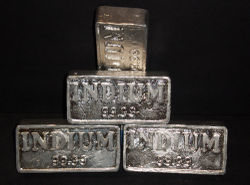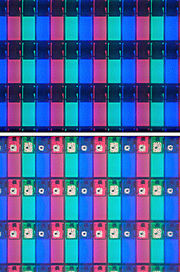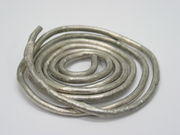Indium
|
|||||||||||||||||||
| Appearance | |||||||||||||||||||
|---|---|---|---|---|---|---|---|---|---|---|---|---|---|---|---|---|---|---|---|
silvery lustrous gray |
|||||||||||||||||||
| General properties | |||||||||||||||||||
| Name, symbol, number | indium, In, 49 | ||||||||||||||||||
| Pronunciation | /ˈɪndiəm/ IN-dee-əm | ||||||||||||||||||
| Element category | post-transition metal | ||||||||||||||||||
| Group, period, block | 13, 5, p | ||||||||||||||||||
| Standard atomic weight | 114.818g·mol−1 | ||||||||||||||||||
| Electron configuration | [Kr] 4d10 5s2 5p1 | ||||||||||||||||||
| Electrons per shell | 2, 8, 18, 18, 3 (Image) | ||||||||||||||||||
| Physical properties | |||||||||||||||||||
| Phase | solid | ||||||||||||||||||
| Density (near r.t.) | 7.31 g·cm−3 | ||||||||||||||||||
| Liquid density at m.p. | 7.02 g·cm−3 | ||||||||||||||||||
| Melting point | 429.7485 K, 156.5985 °C, 313.8773 °F | ||||||||||||||||||
| Boiling point | 2345 K, 2072 °C, 3762 °F | ||||||||||||||||||
| Heat of fusion | 3.281 kJ·mol−1 | ||||||||||||||||||
| Heat of vaporization | 231.8 kJ·mol−1 | ||||||||||||||||||
| Specific heat capacity | (25 °C) 26.74 J·mol−1·K−1 | ||||||||||||||||||
| Vapor pressure | |||||||||||||||||||
|
|||||||||||||||||||
| Atomic properties | |||||||||||||||||||
| Oxidation states | 3, 2, 1 (amphoteric oxide) | ||||||||||||||||||
| Electronegativity | 1.78 (Pauling scale) | ||||||||||||||||||
| Ionization energies | 1st: 558.3 kJ·mol−1 | ||||||||||||||||||
| 2nd: 1820.7 kJ·mol−1 | |||||||||||||||||||
| 3rd: 2704 kJ·mol−1 | |||||||||||||||||||
| Atomic radius | 167 pm | ||||||||||||||||||
| Covalent radius | 142±5 pm | ||||||||||||||||||
| Van der Waals radius | 193 pm | ||||||||||||||||||
| Miscellanea | |||||||||||||||||||
| Crystal structure | tetragonal | ||||||||||||||||||
| Magnetic ordering | diamagnetic[1] | ||||||||||||||||||
| Electrical resistivity | (20 °C) 83.7 nΩ·m | ||||||||||||||||||
| Thermal conductivity | (300 K) 81.8 W·m−1·K−1 | ||||||||||||||||||
| Thermal expansion | (25 °C) 32.1 µm·m−1·K−1 | ||||||||||||||||||
| Speed of sound (thin rod) | (20 °C) 1215 m/s | ||||||||||||||||||
| Young's modulus | 11 GPa | ||||||||||||||||||
| Mohs hardness | 1.2 | ||||||||||||||||||
| Brinell hardness | 8.83 MPa | ||||||||||||||||||
| CAS registry number | 7440-74-6 | ||||||||||||||||||
| Most stable isotopes | |||||||||||||||||||
| Main article: Isotopes of indium | |||||||||||||||||||
|
|||||||||||||||||||
Indium (pronounced /ˈɪndiəm/ IN-dee-əm) is a chemical element with chemical symbol In and atomic number 49. This rare, very soft, malleable and easily fusible post-transition metal is chemically similar to aluminium or gallium. Zinc ores are the primary source of indium. It is named for the indigo blue line in its spectrum that was the first indication of its existence in ores, as a new and unknown element.
Indium's current primary application is to form transparent electrodes from indium tin oxide in liquid crystal displays and touchscreens, and this use largely determines its global mining production. It is widely used in thin-films to form lubricated layers (during World War II it was widely used to coat bearings in high-performance aircraft). It is also used for making particularly low melting point alloys, and is a component in some lead-free solders.
Radioactive indium-111 is used in indium leukocyte imaging, a nuclear medicine test which uses the isotope as an imaging agent to follow the movement of leukocytes in the body.
Contents |
Characteristics

Indium is a very soft, silvery-white, relatively rare true metal with a bright luster. As a pure metal, indium emits a high-pitched "cry", when it is bent.[2] Both gallium and indium are able to wet glass. Indium has a standard electrode potential of +0.34V, the same as thallium.
Unlike its period 5 neighbor cadmium, indium is not a cumulative poison.
Isotopes
Indium in nature consists of two primordial nuclides. One unusual property of indium (shared only with rhenium) is that although it possesses a stable isotope, its most common (abundant) isotope (95.7%) is slightly and measurably radioactive. This isotope, indium-115 very slowly decays by beta emission to tin. This decay has a half-life of 4.41 × 1014 years, four orders of magnitude larger than the age of the universe and nearly 50,000 times longer than that of natural thorium.[3]
Creation
Indium is created via the long S-process in low-medium mass stars (.6 -> 10 solar masses). This takes thousands of years to do. It requires a cadmium atom to capture sufficient neutrons and then undergo Beta decay.
History
In 1863 the German chemists Ferdinand Reich and Hieronymous Theodor Richter were testing ores from the mines around Freiberg, Saxony. They dissolved the minerals pyrite, arsenopyrite, galena and sphalerite in hydrochloric acid and distilled the raw zinc chloride. As it was known that ores from that region sometimes contain thallium they searched for the green emission lines with spectroscopic methods. The green lines were absent but a blue line was present in the spectrum. As no element was known with a bright blue emission they concluded that a new element was present in the minerals. They named the element with the blue spectral line indium, from the indigo color seen in its spectrum.[4][5] Richter went on to isolate the metal in 1864.[6] At the World Fair 1867 an ingot of 0.5 kg (1.1 lb) was presented.[7]
Occurrence and consumption
Indium ranks 61st in abundance in the Earth's crust at approximately 0.25 ppm,[8] which means it is more than three times as abundant as silver, which occurs at 0.075 ppm.[9] Fewer than 10 indium minerals are known, none occurring in significant deposits. Examples are the dzhalindite (In(OH)3) and indite (FeIn2S4).[10]
Resources
Based on content of indium in zinc ore stocks, there is a worldwide reserve base of approximately 6,000 tonnes of economically viable indium.[11] This figure has led to estimates suggesting that, at current consumption rates, there is only 13 years' supply of indium left.[12] However, the Indium Corporation, the largest processor of indium, claims that, on the basis of increasing recovery yields during extraction, recovery from a wider range of base metals (including tin, copper and other polymetallic deposits) and new mining investments, the long-term supply of indium is sustainable, reliable and sufficient to meet increasing future demands.[13]
This conclusion also seems reasonable in light of the fact that silver, three times less abundant than indium in the earths crust,[14] is currently mined at approximately 18,300 tonnes per annum,[15] which is 40 times greater than current indium mining rates.
Production
The lack of indium mineral deposits and the fact that indium is enriched in sulfidic lead, tin, copper, iron and predominately in zinc deposits, makes zinc production the main source for indium. The indium is leached from slag and dust of zinc production. Further purification is done by electrolysis.[7]
Indium is produced mainly from residues generated during zinc ore processing but is also found in iron, lead, and copper ores.[2] Canada is a leading producer of indium. The Teck Cominco refinery in Trail, British Columbia, is the largest single source indium producer, with production of 32,500 kg in 2005, 41,800 kg in 2004 and 36,100 kg in 2003. South American Silver's Malku Khota property in Bolivia is the largest resource of indium with an indicated resource of 845,000kg and inferred resource of 968,000kg.Adex Mining Inc.’s Mount Pleasant Mine in New Brunswick, Canada, holds about 15 to 20% of the world’s total known indium resources.[16]
The amount of indium consumed is largely a function of worldwide LCD production. Worldwide production is currently 476 tonnes per year from mining and a further 650 tonnes per year from recycling.[13] Demand has risen rapidly in recent years with the popularity of LCD computer monitors and television sets, which now account for 50% of indium consumption.[17] Increased manufacturing efficiency and recycling (especially in Japan) maintain a balance between demand and supply. Demand increased as the metal is used in LCDs and televisions, and supply decreased when a number of Chinese mining concerns stopped extracting indium from their zinc tailings. In 2002, the price was US$94 per kilogram. The recent changes in demand and supply have resulted in high and fluctuating prices of indium, which from 2005 to 2007 ranged from US$700/kg to US$1,000/kg.[11] Demand for indium may increase with large-scale manufacture of CIGS-based thin film solar technology starting by several companies in 2008, including Nanosolar and Miasole, although zinc oxide is often used instead.
Applications

The first large-scale application for indium was as a coating for bearings in high-performance aircraft engines during World War II. Afterward, production gradually increased as new uses were found in fusible alloys, solders, and electronics. In the 1950s, tiny beads of it were used for the emitters and collectors of PNP alloy junction transistors. In the middle and late 1980s, the development of indium phosphide semiconductors and indium tin oxide thin films for liquid crystal displays (LCD) aroused much interest. By 1992, the thin-film application had become the largest end use.[18][19]
Electronics
- Indium oxide (In2O3) and indium tin oxide (ITO) are used as a transparent conductive coating applied to glass substrates in the making of electroluminescent panels.
- Some indium compounds such as indium antimonide, indium phosphide,[20] and indium nitride[21] are semiconductors with useful properties.
- Indium is used in the synthesis of the semiconductor copper indium gallium selenide (CIGS), which is used for the manufacture of thin film solar cells.[22]
- Used in light-emitting diodes (LEDs) and laser diodes based on compound semiconductors such as InGaN, InGaP that are fabricated by Metalorganic Vapor Phase Epitaxy (MOVPE) technology.
- The ultrapure metalorganics of indium, specifically high purity trimethylindium (TMI) is used as a precursor in III-V compound semiconductors, while it is also used as the semiconductor dopant in II-VI compound semiconductors.[23]
Metal and alloys

- Very small amounts used in aluminium alloy sacrificial anodes (for salt water applications) to prevent passivation of the aluminium.
- To bond gold electrical test leads to superconductors, indium is used as a conducting glue and applied under a microscope with precision tweezers.
- In the form of a wire it is used as a vacuum seal and a thermal conductor in cryogenics and ultra-high vacuum applications. For example, in manufacturing gaskets which deform to fill gaps.[24]
- Used as a calibration material for Differential scanning calorimetry.
- It is an ingredient in the alloy Galinstan, which is liquid at room temperature while not being toxic like mercury.
Other uses
- Indium tin oxide is used as a light filter in low pressure sodium vapor lamps. The infrared radiation is reflected back into the lamp, which increases the temperature within the tube and therefore improves the performance of the lamp.[19]
- Indium's melting point of 429.7485 K (156.5985 °C) is a defining fixed point on the international temperature scale ITS-90.
- Indium's high neutron capture cross section for thermal neutrons makes it suitable for use in control rods for nuclear reactors, typically in an alloy containing 80% silver, 15% indium, and 5% cadmium.
- In nuclear engineering, the (n,n') reactions of 113In and 115In are used to determine magnitudes of neutron fluxes.
- Indium is also used as a thermal interface material by personal computer enthusiasts in the form of pre-shaped foil sheets fitted between the heat-transfer surface of a microprocessor and its heat sink. The application of heat partially melts the foil and allows the indium metal to fill in any microscopic gaps and pits between the two surfaces, removing any insulating air pockets that would otherwise compromise heat transfer efficiency.
- 111In emits gamma radiation and is used in indium leukocyte imaging, or indium scintigraphy, a technique of medical imaging. Indium leukocyte scintigraphy has many applications, including early phase drug development, and the monitoring of activity of white blood cells. For the test, blood is taken from the patient, white cells removed, labeled with the radioactive 111In, then re-injected back into the patient. Gamma imaging will then reveal any areas of on-going white cell localization such as new and developing areas of infection.
Precautions
Pure indium in metal form is considered non-toxic by most sources. In the welding and semiconductor industries, where indium exposure is relatively high, there have been no reports of any toxic side-effects.
This may not be the case with indium compounds. For example, anhydrous indium trichloride (InCl3) is quite toxic, and indium phosphide (InP) is both toxic and a suspected carcinogen.[25][26]
See also
- Indium compounds
References
- ↑ Magnetic susceptibility of the elements and inorganic compounds, in Handbook of Chemistry and Physics 81st edition, CRC press.
- ↑ 2.0 2.1 Alfantazi, A. M.; Moskalyk, R. R. (2003). "Processing of indium: a review". Minerals Engineering 16 (8): 687–694. doi:10.1016/S0892-6875(03)00168-7.
- ↑ Audi, Georges (2003). "The NUBASE Evaluation of Nuclear and Decay Properties". Nuclear Physics A (Atomic Mass Data Center) 729: 3–128. doi:10.1016/j.nuclphysa.2003.11.001.
- ↑ Reich, F.; Richter, T. (1863). "Ueber das Indium" (in German). Journal für Praktische Chemie 90 (1): 172–176. doi:10.1002/prac.18630900122.
- ↑ Venetskii, S. (1971). "Indium". Metallurgist 15 (2): 148–150. doi:10.1007/BF01088126.
- ↑ Reich, F.; Richter, T. (1864). "Ueber das Indium" (in German). Journal für Praktische Chemie 92 (1): 480–485. doi:10.1002/prac.18640920180.
- ↑ 7.0 7.1 Schwarz-Schampera, Ulrich; Herzig, Peter M. (2002). Indium: Geology, Mineralogy, and Economics. Springer. ISBN 9783540431350. http://books.google.com/?id=k7x_2_KnupMC&pg=PA1.
- ↑ "The Element Indium". It's Elemental. http://education.jlab.org/itselemental/ele049.html. Retrieved 2007-12-26.
- ↑ "The Element Silver". It's Elemental. http://education.jlab.org/itselemental/ele047.html. Retrieved 2007-12-26.
- ↑ Sutherland, J. K. (1971). "A second occurrence of dzhalindite". The Canadian Mineralogist 10 (5): 781–786. http://canmin.geoscienceworld.org/cgi/content/abstract/10/5/781.
- ↑ 11.0 11.1 "Mineral Commodities Summary 2007: Indium" (pdf). United States Geological Survey. http://minerals.usgs.gov/minerals/pubs/commodity/indium/indiumcs07.pdf. Retrieved 2007-12-26.
- ↑ "How Long Will it Last?". New Scientist 194 (2605): 38–39. May 26, 2007. ISSN 0262-4079. http://environment.newscientist.com/channel/earth/mg19426051.200-earths-natural-wealth-an-audit.html.
- ↑ 13.0 13.1 "Indium and Gallium Supply Sustainability September 2007 Update" (pdf). 22nd EU PV Conference, Milan, Italy. http://www.indium.com/_dynamo/download.php?docid=552. Retrieved 2007-12-26.
- ↑ "Indium Price Supported by LCD Demand and New Uses for the Metal". September 6, 2009. http://geology.com/articles/indium.shtml.
- ↑ "Top World Silver Producers" (pdf). World Silver Survey 2007. http://www.nma.org/pdf/g_silver_producers.pdf.
- ↑ Wright, Phillip. “Mineral and Metal Commodity Review: Tin.” Natural Resources Canada, 1996.
- ↑ "Indium Price Supported by LCD Demand and New Uses for the Metal" (pdf). Geology.com. http://geology.com/articles/indium.shtml. Retrieved 2007-12-26.
- ↑ Tolcin, Amy C.. "Mineral Yearbook 2007: Indium" (pdf). United States Geological Survey. http://minerals.usgs.gov/mineralofthemonth/indium.pdf. Retrieved 200-02-03.
- ↑ 19.0 19.1 Downs, Anthony John (1993). Chemistry of Aluminium, Gallium, Indium, and Thallium. Springer. pp. 89 and 106. ISBN 9780751401035. http://books.google.com/?id=v-04Kn758yIC.
- ↑ Bachmann, K. J. (1981). "Properties, Preparation, and Device Applications of Indium Phosphide". Annual Review of Materials Science 11: 441–484. doi:10.1146/annurev.ms.11.080181.002301.
- ↑ Bhuiyan, Ghani; Hashimoto, Akihiro; Yamamoto, Akioare (2003). "Indium nitride (InN): A review on growth, characterization, and properties". Journal of Applied Physics 94: 2779. doi:10.1063/1.1595135.
- ↑ Powalla, M.; Dimmler, B. (2000). "Scaling up issues of CIGS solar cells". Thin Solid Films 361-362: 540–546. doi:10.1016/S0040-6090(99)00849-4.
- ↑ Shenai, Deodatta V.; Timmons, Michael L.; DiCarlo Jr., Ronald L.; Marsman, Charles J. (2004). "Correlation of film properties and reduced impurity concentrations in sources for III/V-MOVPE using high-purity trimethylindium and tertiarybutylphosphine". Journal of Crystal Growth 272 (1–4): 603–608. doi:10.1016/j.jcrysgro.2004.09.006.
- ↑ ed. by G. L. Weissler ... (1990). Vacuum physics and technology. San Diego: Acad. Press. p. 296. ISBN 9780124759145. http://books.google.com/?id=tfLWfAx1ZWQC&pg=PA296.
- ↑ Tanaka, A.; Hirata, M.; Omura, M., (2002). "Pulmonary toxicity of indium-tin oxide and indium phosphide after intratracheal instillations into the lung of hamsters". Journal of the Occupational Health 44: 99–102. doi:10.1539/joh.44.99.
- ↑ Blazka, ME; Dixon, D., Haskins, E., Rosenthal, G. J. (1994). "Pulmonary toxicity to intratracheally administered indium trichloride in Fischer 344 rats". Fundamental Applied Toxicology 22: 231–239. doi:10.1006/faat.1994.1027.
External links
| H | He | ||||||||||||||||||||||||||||||||||||||||
| Li | Be | B | C | N | O | F | Ne | ||||||||||||||||||||||||||||||||||
| Na | Mg | Al | Si | P | S | Cl | Ar | ||||||||||||||||||||||||||||||||||
| K | Ca | Sc | Ti | V | Cr | Mn | Fe | Co | Ni | Cu | Zn | Ga | Ge | As | Se | Br | Kr | ||||||||||||||||||||||||
| Rb | Sr | Y | Zr | Nb | Mo | Tc | Ru | Rh | Pd | Ag | Cd | In | Sn | Sb | Te | I | Xe | ||||||||||||||||||||||||
| Cs | Ba | La | Ce | Pr | Nd | Pm | Sm | Eu | Gd | Tb | Dy | Ho | Er | Tm | Yb | Lu | Hf | Ta | W | Re | Os | Ir | Pt | Au | Hg | Tl | Pb | Bi | Po | At | Rn | ||||||||||
| Fr | Ra | Ac | Th | Pa | U | Np | Pu | Am | Cm | Bk | Cf | Es | Fm | Md | No | Lr | Rf | Db | Sg | Bh | Hs | Mt | Ds | Rg | Cn | Uut | Uuq | Uup | Uuh | Uus | Uuo | ||||||||||
|
|||||||||||||||||||||||||||||||||||||||||
|
|||||||||||||||||||||||||||||||||||||||||
|
|||||